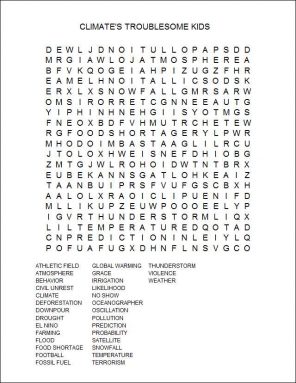Climate’s troublesome kids
The recurring climate events El Niño and La Niña trigger long-lived changes to weather around the world
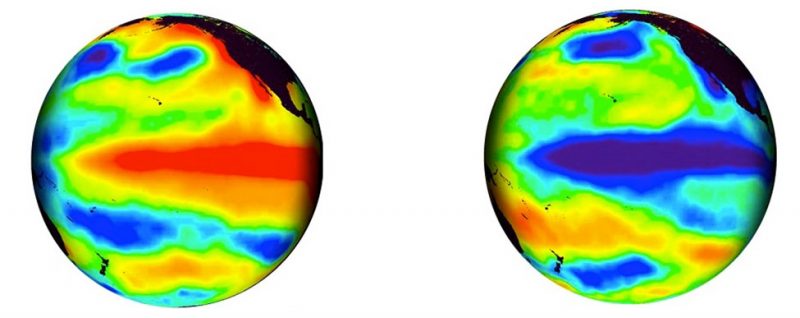
Rain starting falling on Chile in late May, 2002 — and just wouldn’t stop. Within days, the skies unleashed the heaviest rainfall this country had seen in more than a century. Towns flooded. Tens of thousands of people fled their homes. Thirteen people died.
Clearly, this was no ordinary downpour.
Scientists blamed the heavy rains on a climate disturbance in the ocean and atmosphere that returns every 3 to 7 years. It’s called an El Niño (ell NEEN yo), which is Spanish for “the boy.” And although born in the Pacific Ocean, it can trigger extreme weather half a world away. It’s not the only climate kid, though.
A related disturbance can affect weather in equally dramatic ways as well. It’s called La Niña (lah NEEN ya) — for “the girl.” These troublesome children can each perturb weather for a year or more at a time.
Fairly steady winds normally blow from east to west across the northern tropical seas. Such regular breezes became known as the northern “trade winds” for the boost they gave trading ships sailing west.
The Pacific trade winds drag warm surface waters westward. This leaves the central and eastern regions of the Pacific — such as near the coast of South America — cooler. But during an El Niño, these winds ease up. Tropical waters in the central and eastern regions warm. On the other side of the ocean, near Indonesia and Australia, the surface waters cool.
The warming in the central and eastern Pacific triggers changes in air pressure across the ocean. Air pressure is the force of the weight of the atmosphere pushing down on a place. Scientists call these pressure changes the Southern Oscillation (oscillation means fluctuation). They are triggered by the temperature changes brought by El Niño. So the phenomenon’s full name is El Niño-Southern Oscillation, or ENSO. Climate scientists usually detect an El Niño toward the end of a year. Its major effects, however, typically are not felt until the following year.
El Niño’s extra warmth fuels the growth of thunderstorms. These storms can dump tremendous amounts of rain on coastal regions of South America.
But these aren’t the only regions affected. In late 2002, for instance, Australians encountered their own El Niño-driven extreme weather. They called it the “Big Dry.” Rain didn’t fall for months, ushering in a terrible drought. Crops died. Livestock starved from lack of food and water. It appeared as though El Niño had opened a faucet over South America — and turned off the spigot that usually watered Australia.
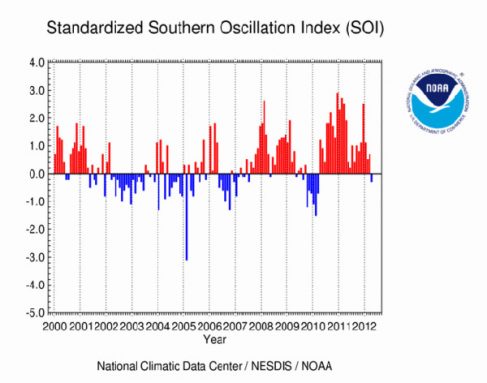
Still, many climate scientists considered the 2002-2003 El Niño mild. One that began in 1997 was far worse: It eventually released rains that eroded some of California’s coastline and was the cause of major ice storms in the United States.
Much attention in recent years has focused on El Niños and the destruction they can bring. But the event is one extreme end of a climate cycle.
An El Niño occurs when eastern Pacific waters warm up. Sometimes those waters instead cool down, when the trade winds grow stronger than normal and blow more warm surface water away. This change marks the arrival of the other extreme in the ENSO cycle: La Niña. Sometimes, as in 1998, the two events happen back to back. In that year, a major El Niño morphed into a La Niña. By the time these climate kids finished, they had caused enough warming in the Pacific and Indian oceans to kill as much as 10 percent of the world’s coral.
More often, years of normal weather separate the period when each “kid” wreaks its damage. And make no mistake: La Niña-linked changes in weather can be as devastating as El Niño’s. In July 2012, for instance, scientists connected a 2011 La Niña with a severe drought that caused severe food shortages and famine throughout the Horn of Africa.
Scientists want to understand how these climate oscillations fit into the larger picture of Earth’s changing climate. In recent years, the average temperature of the planet has been climbing, something known as global warming. Will that alter the strength or timing of ENSO events?
“We know the Earth is warming,” notes oceanographer Benjamin Giese at Texas A&M University in College Station. Is this changing world affecting the strength of ENSO events, he asks. For instance, any change in El Niño’s strength “might have an impact on things like drought or flood or storminess,” he says — “not just in the United States, but globally.”
Predicting climate, not weather
Scientists can see an El Niño coming, but they can’t tell how it will behave.
Using computers, scientists “predict whether or not an El Niño is going to happen fairly well,” says Giese. “But we don’t have much sense of how strong the El Niño is going to be.”
One reason: El Niños are not storms. Instead, they are features of Earth’s ever-evolving climate.
The word “weather” is used to describe specific events like storms and droughts, lightning and rainfall — things that happen at a given time in very specific places. Weather tends to be relatively local and short-lived. It explains why rains hit your town but not one a mile away, why fog rolled in 10 minutes ago, or why sudden winds blew autumn leaves off your town’s trees.
Climate refers to the weather conditions in an area over months to years. It’s almost like the average of weather over a long time. The climate for your region may include predictions of chilly Novembers, heavy rains in December and major snowfalls from January to March. Climate may also predict warm summers and regularly wet springtimes.
To be able to study climate and find changes in its normal patterns, scientists need lots of data about a region’s weather. There have been only about 20 El Niños since the 1950s, when scientists started studying these events in great detail. So scientists lack enough data to develop a good picture of how the “average” El Niño should behave.
Giese likens the situation to a coin toss. The more times you flip, the better your information.
“If you flip a coin a lot of times, you’ll eventually see something close to 50:50 for heads and tails,” he says. “But if you only flip twice, you have a good chance of getting two heads” — and a misleading expectation of what should come next.
Eyes on ENSO
It is difficult to learn much about past El Niños, but scientists now use clever tools to learn as much as they can about present and future events. After the 1982-1983 El Niño, for example, a group of nations jointly created the Tropical Atmosphere Ocean (TAO) array. This giant scientific instrument includes 70 buoys all anchored to the floor of the Pacific. The buoys now collect information about the ocean — including humidity, wind speed and temperatures above and below the sea surface. Their sensors broadcast that information to satellites passing overhead a few times every day. Collected by researchers, these measurements can provide the earliest evidence of an El Niño’s signature warming.
Satellites themselves can provide powerful eyes on the ocean, as well. The GRACE satellite, for example, measures how much water exists in different parts of the world, explains oceanographer Carmen Boening. At NASA’s Jet Propulsion Laboratory in Pasadena, Calif., she studies the biology, chemistry and movements of oceans. GRACE “weighs” the water in the ocean by measuring its gravitational pull. Anything with mass has gravity. The more mass something has, the more gravity, or pull, it has on other objects with mass. As the amount of water in the ocean shifts, its mass and gravitational pull on GRACE shift as well.
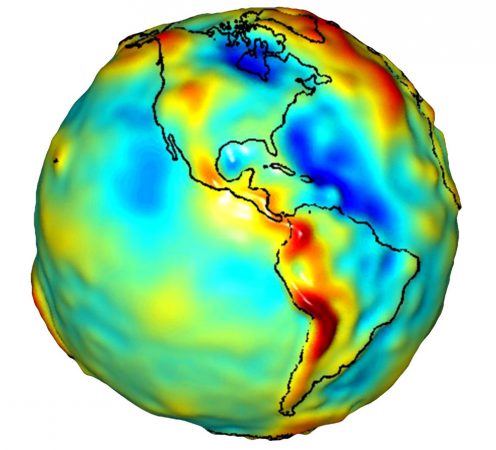
University of Texas Center for Space Research, NASA
In 2011, Boening and her collaborators used GRACE data to show that ocean levels dropped during that year’s La Niña. A La Niña exhibits behavior opposite to an El Niño: It triggers heavy rains over Australia, and can leave South America dry and prone to drought.
GRACE also helped identify where the water missing from the oceans ended up. “If it’s not in the ocean, it must be somewhere else,” Boening says. By using the satellite to study moisture over land, her team connected the La Niña cycle to “more water over Australia and Southeast Asia, where there were a lot of floods.”
From bad to worse
Satellites can also help identify and understand how human activity can affect ENSO events. In one recent study, researchers used satellite data to show that the removal of forests can make effects of a bad El Niño even worse.
Miriam Marlier is finishing graduate work in atmospheric science at Columbia University in New York City. She works with other scientists to use satellite data to probe how deforestation — the clearing of large forests by humans — might affect hazards like wildfires. In a study published in the August 2012 journal Nature Climate Change, she and her collaborators looked at fires in Southeast Asia.
That part of the world is “really the center of where changes from El Niño are going to happen,” she says.
Marlier’s team studied satellite data on atmospheric and fire conditions for a 10-year period. El Niño events boosted the likelihood of fires there, her team found.
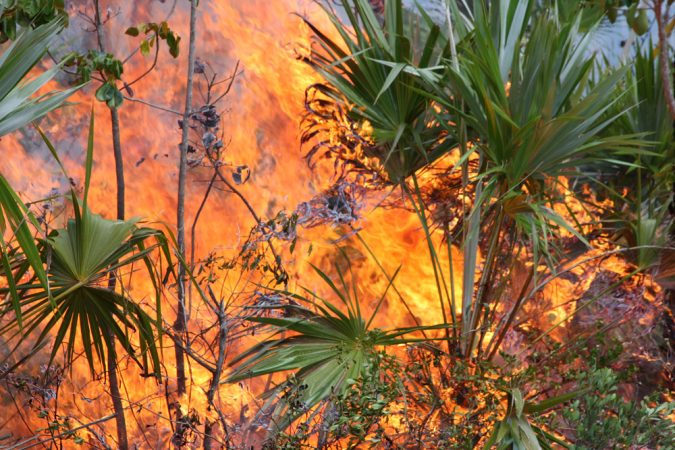
Changes to the landscape are behind the boost, says Marlier. Some parts of the region used to be swamp forests. These areas were so perpetually damp that they didn’t burn, even when an El Niño brought a drought. But as people have carved canals through the swamps and drained away the water, the forest soils have also dried out. The result, she says: a serious risk of wildfires. Former swamps can be engulfed in fires that now burn out of control.
Another concern: Those fires release pollutants into the air that can harm human health. Roughly 15,000 additional deaths per year can be blamed on the extra pollution created by wildfires during El Niño events, Marlier’s team estimates.
Global warming may also worsen an ENSO event like El Niño.
Earth’s average temperature has been increasing. Scientists suspect an increasing amount of greenhouse gases is likely to blame. The burning of fossil fuels like natural gas and coal are among the human activities that spew these heat-trapping gases.
In 2011, Texans sweated through the hottest, driest spring and summer on record. The rivers once used for irrigation dried up. Crops and livestock ate died. Losses from the drought cost Texas farmers and consumers an estimated $5.2 billion.
And those weren’t the only problems. Janet Raloff of Science News reported that in Texas, “a state obsessed with football, Dallas had to close more than two dozen athletic fields as clay soils shrank and formed cracks more than half a meter deep. One county hired some 100 bridge and road crews to fix pavement cracks all summer long. The shifting soil twisted water mains, breaking more than 200 in Fort Worth alone, 20 in a single day.”
The 2010 to 2011 La Niña was held largely — but not totally — responsible. Since the 1960s, the chance that Texas will see extremely hot, dry weather in a La Niña year has mushroomed 20-fold. Human-induced global warming underlies this increase, scientists reported in July 2012.
Climate-caused conflict
El Niños can even lead to an increased risk of violence. In 2011, researchers at Princeton and Columbia universities found that areas heavily impacted by El Niños were twice as likely to experience major civil unrest as those countries that largely escape the event’s effects. They defined major civil unrest as disputes between governments and other organized parties (such as rebel groups) that that caused at least 25 deaths. The researchers found that very poor parts of the world affected by El Niños were especially susceptible to such conflict.
Those findings, reported in the journal Nature, make sense, says statistician Andrew Solow. At the Woods Hole Oceanographic Institution in Massachusetts, he studies the probability, or chance, that certain events will occur. As he explained to Science News at the time, incomes in many poor countries are closely linked to farming — and therefore the weather. So poor harvests and diminishing food supplies (caused by the weather changes triggered by an El Niño or La Niña) can leave large numbers of people hungry, angry and out of work. These people are now available to engage in protests, terrorism and wars.
What comes next?
Marlier’s study of El Niño impacts in Southeast Asia included data collected through 2006. Another El Niño has occurred since then. It ended in early 2010. That event, unlike earlier ones, came on fast and then turned into a La Niña cooling system. So it’s been about 3 years since the last El Niño. That could mean another is approaching … or not.
Last summer, the National Oceanic and Atmospheric Administration’s Climate Prediction Center issued an “El Niño watch.” El Niño seemed likely for this winter, it said. But it never materialized. New studies now suggest the 2012 to 2013 El Niño is a no-show.
Instead, it looks like we’re in for what one NASA climate scientist calls “La Nada.” That is where the sea surface temperatures are neither too hot nor too cold. They’re just about average.
Clearly, scientists say, there’s still much to learn about worldwide climate patterns.
Power Words
buoy An anchored, floating device that may help with navigation, show hazards in the water or record scientific data.
current A body of water or air moving in a definite direction.
climate The weather conditions prevailing in an area in general or over a long period.
drought An extended period of abnormally low rainfall; a shortage of water resulting from this.
ENSO Short for El Niño-Southern Oscillation: It is a natural cycle of changing temperatures in the ocean and atmosphere, near the equator in the Pacific Ocean. During ENSO events, atmospheric pressure also changes in affected areas.
atmospheric pressure The pressure exerted by the weight of the atmosphere.
global warming The gradual increase in the overall temperature of Earth’s atmosphere due to the greenhouse effect. This effect is caused by increased levels of carbon dioxide, chlorofluorocarbons and other gases in the air, many of them released by human activity.
oceanography The branch of science that deals with the physical and biological properties and phenomena of the sea.
humidity A measure of the amount of water vapor in the atmosphere.
gravity The force that attracts any body with mass toward any other body with mass. The more mass there is, the greater the gravity.
Word Find (click here to print puzzle)
